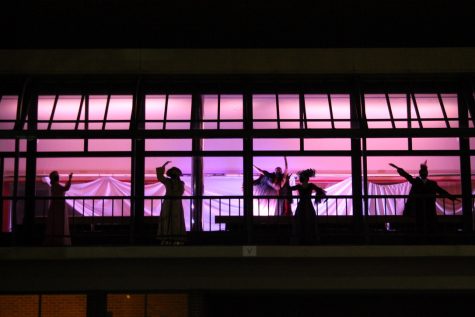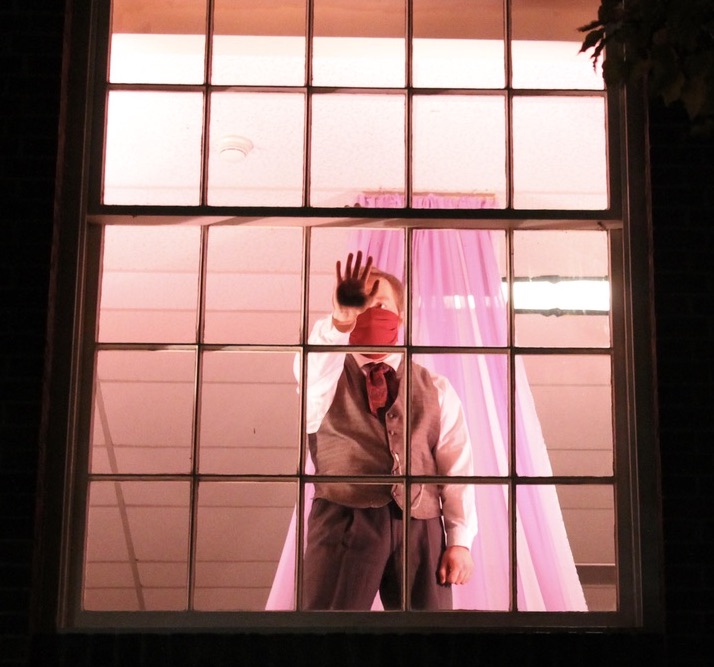Theatre’s tell-tale performance
Shadow puppetry, devising, rapping, movement pieces and more at “The Tell-Tale Gaze” exhibit
Jackson Stoffel starred in “The Three O’clock Hour: Premature Burial.”
November 10, 2020
Theatre students performed live editions of popular works of Edgar Allan Poe, such as “The Raven,” “The Premature Burial,” “The Tell-Tale Heart” and “The Masque of the Red Death” on the evenings of Oct. 29-31 and Nov. 5-7.
Described by the event advertisement as an exploration of “the mystery and the macabre of Poe’s mind,” audience members were invited to watch Poe’s texts “come to life” through the windows of McConnell Hall.

After getting tickets scanned at a table outside the west entrance of Samuelson Hall, attendees received a link to an online program to guide them through their experience.
Audience members were then divided into small groups and assigned a Roman numeral from one through 12.
At various map points, the groups could find their Roman numeral attached to a wall or window of McConnell Hall.
The sound of a clocktower tolling signified to each group to move to the next map point to see the next performance.
With each bong of the clocktower, audience members were pulled along by invisible puppet strings, much like one performance, “Cask Shadow.”
Inspired by Poe’s “The Cask of Amontillado,” this exhibit at the main entrance of McConnell Hall featured one performer controlling another with imaginary marionettes, set to narration of excerpts from the story.
Another rendition, “Into the Pit,” inspired by Poe’s “The Pit and the Pendulum,” was an audio-only experience in an alleyway wedged between McConnell and Barge Hall.
The audience’s imagination was a key element in this performance, with only a slightly ajar door to stare at while narrated snippets from “The Pit and the Pendulum” played over a speaker.
The audio echoed off the walls in the narrow alleyway, allowing the audience to feel the audio, adding extra submersion to the experience.
At “The Two O’clock Hour: Alone,” a pre-recorded performance inspired by Poe’s poem “Alone” played on a screen.
Senior theatre performance major Luis Hernandez-Mejia, the star of “Alone” and an actor in “The Masque of the Red Death,” did not feel limited by wearing a mask during his performances.
“I think wearing a mask allows you to embody and embrace a character that you’re supposed to portray,” Hernandez-Mejia said. “Going into the mask, I need to imagine, ‘Okay, I’m wearing this mask. Who is my character? Who am I portraying, and how can I embody and show the characteristics of this character?’”
The performance was unique for Hernandez-Mejia. He describes the exhibit as a “dark ride experience” similar to “The Haunted Mansion” at Disneyland.
“When it comes to acting or in theatre in general, I don’t think it should always be limited to the theatre because if you expand beyond that, if you make the whole building your set, there’s just so much creativity and so much potential there, that I think it could be sometimes overlooked,” Hernandez-Mejia said.
Along with using the whole building as their set, the performers used mixed media to create a performance, “In the Shadows,” that included no actors.
Inspired by Poe’s “The Black Cat,” “In the Shadows” was a shadow puppet performance projected onto the windows of the east side of McConnell Hall, using soundscape such as ambient music and cat meowing to complement the puppetry.
“The Tell-Tale Gaze” exhibit was a collaborative process between many members of the theatre department, according to Kathryn Stahl, the director for the exhibit and a lecturer in the theatre department for theatre performance and education.

Stahl said the idea to use works by Edgar Allan Poe to create movement pieces was decided on well before the COVID-19 pandemic hit.
“Originally it was going to be something totally different,” Stahl said. “And then [COVID-19] hit, and it became, ‘How can we still do live theatre in this time?’”
Through conversations with staff and students, Stahl decided to situate some of the performances in the era in which Poe lived, the early 19th century.
However, some were modernized with the use of Zoom. Devised theatre, which is theatre that begins without a script, allowed the department more creative freedom, which resulted in something the theatre department has never done before, Stahl said.
“This opportunity said, ‘How can you turn any space into a performance space?’ and ‘How can you bring life within the frame?’” Stahl said.
COVID-19 allowed students and directors to create a more “intimate” experience, according to Stahl, and it was easy to integrate technologies such as Zoom and Microsoft Sway, the software used to create the program for the event.
In addition, many themes found in Poe’s work can be found during this “time of [COVID-19],” Stahl said.
“All of the themes of romance, of death, of distance, of the fear of premature death, are all things that are so relevant to the now,” Stahl said.

